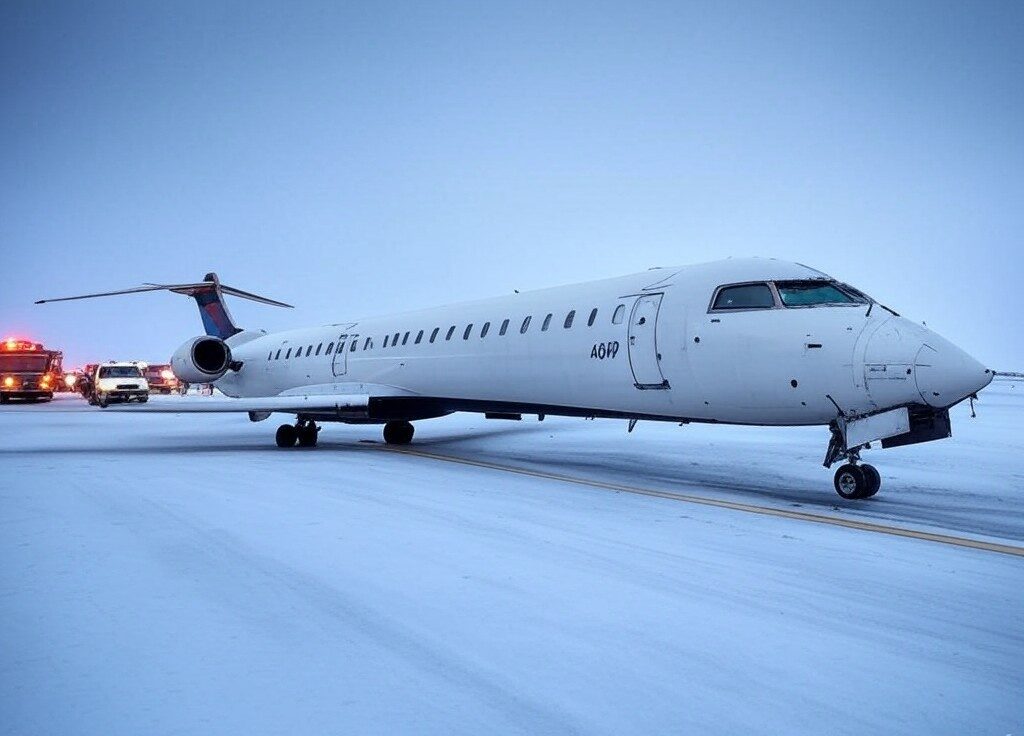Delta Flight 4819 Crash-Lands at Toronto Pearson Airport

✈️Toronto Pearson Crash
🔍In-Depth Analysis of Delta Flight 4819 Incident
On February 17, 2025, a dramatic incident unfolded at Toronto Pearson International Airport when Delta Connection Flight 4819—a Bombardier CRJ900LR operated by Endeavor Air—crash-landed during a challenging winter landing. With 80 people on board, the flight experienced a severe runway excursion and ended up flipped upside down on the tarmac. Despite the dramatic nature of the event, all passengers and crew were safely evacuated, with only minor to moderate injuries reported.
In this in-depth report, we explore every facet of the Toronto Pearson Crash, analyze the factors contributing to the accident, review expert opinions, and discuss the immediate aftermath and ongoing investigation. If you’re searching for reliable news on the Toronto Pearson Crash, Delta Flight 4819, or Toronto plane crash, this article provides all the fresh insights and updates you need.
What Happened? – Overview of the Delta Flight 4819 Incident
On that fateful afternoon, weather conditions at Toronto Pearson International Airport were far from ideal. A heavy winter storm had recently passed through the region, leaving the runway covered in snow and subject to gusty winds. Delta Connection Flight 4819, carrying 76 passengers and 4 crew members, attempted a landing under these challenging conditions.
The Landing Sequence
- Approach: The aircraft approached the runway under conditions reported to be “weird” by pilots, with inconsistent runway surfaces and sporadic gusts affecting the descent profile.
- Touchdown: The plane made contact with the runway but hit the surface hard, skidding sideways due to the slick, snowy conditions.
- Crash-Landing: The impact caused the aircraft to lose balance, eventually flipping over and coming to rest upside down on the tarmac.
Despite the severity of the event, emergency response teams mobilized immediately, evacuating all 80 individuals on board safely. Initial reports indicated that between 17 and 18 people sustained injuries, though none were fatal. The swift response by airport emergency crews and the preparedness of Delta Connection’s team ensured that the incident did not escalate into a tragedy.
Detailed Analysis of the Factors Contributing to the Crash
1. Challenging Weather Conditions
Keywords: Toronto Pearson Crash, winter storm, snowy runway, gusty winds
Toronto Pearson International Airport had recently been affected by a significant winter storm. Fresh snowfall and cold temperatures created a slick runway surface. Moreover, the reported gusty winds—with speeds fluctuating and occasional crosswinds—exacerbated the already difficult landing conditions.
External data from Reuters confirms that weather played a critical role in the incident. In aviation, safe landings depend on predictable runway conditions, and in this case, the combination of snow, ice, and wind likely contributed to the loss of control during the landing roll.
2. Runway Conditions and Maintenance
Keywords: Toronto plane crash, runway maintenance, Toronto Pearson runway
The state of the runway at the time was a subject of concern. Although reports mentioned that the runway was “dry” in certain areas, the mixed condition caused by recent snow removal operations could have led to uneven friction. This inconsistency can cause a plane to skid or lose traction, as was observed during Flight 4819’s landing attempt.
Industry experts have noted that ensuring consistent runway conditions is crucial for aircraft braking performance. For more information on runway safety, check our detailed guide on airport safety standards.
3. Aircraft Performance and Pilot Response
Keywords: Delta Flight 4819, pilot response, aircraft performance
The Bombardier CRJ900LR, although known for its efficiency in short- to medium-haul flights, faces performance challenges in adverse weather conditions. Pilot comments described the runway as “weird” and noted that adjustments in airspeed and descent angle were continuously required. While professional training prepares pilots for such conditions, sometimes the compounded effect of rapid weather changes and suboptimal runway conditions can overwhelm even the best-trained crews.
Pilot John Nelson’s firsthand account—shared on social media and later cited by major outlets like Fox News—emphasizes the extraordinary circumstances of the landing, including the fact that the plane “hit the ground hard” and skidded before flipping over.
4. Emergency Response and Evacuation
Keywords: emergency response, plane evacuation, Toronto Pearson crash
One of the most reassuring aspects of this incident was the effective emergency response. Airport fire and rescue teams acted with speed and precision, evacuating passengers and providing immediate medical assistance to those injured. Social media clips and videos captured the chaotic yet efficient evacuation process, highlighting the critical role of trained first responders.
SHOCK FOOTAGE: Delta Flight 4819 crash-lands at Toronto Pearson. 80 onboard; 18 injured (2 critical). Read our full analysis for details. https://t.co/KpwrKDLQs2 pic.twitter.com/61VMFaCSVe
— FoxNewsEnglish (@FoxNewsEng) February 18, 2025
Timeline of Events
Pre-Crash Preparations
- Weather Warnings: Prior to the landing, pilots received updates about the weather conditions, including warnings about gusty winds and mixed runway surfaces.
- Flight Crew Briefing: The crew reviewed landing protocols given the adverse conditions, though some later admitted that the runway conditions were more challenging than anticipated.
The Landing and Crash Sequence
- Touchdown: The aircraft touched down around 2:15 p.m. local time.
- Skidding and Loss of Control: Due to inconsistent runway friction and gusty winds, the plane skidded sideways.
- Overturn: The aircraft lost balance and eventually flipped over, coming to rest upside down on the tarmac.
Immediate Aftermath
- Evacuation: Emergency crews evacuated all 80 occupants swiftly.
- Injuries Reported: Between 17 and 18 people sustained injuries, with critical cases involving a child and two adults.
- Airport Disruption: Toronto Pearson International Airport temporarily halted operations until the runway was cleared and safety was reestablished.
Expert Insights and Industry Perspectives
Expert Opinions on the Incident
Aviation safety experts and meteorologists alike have weighed in on the factors contributing to the crash. According to Reuters, the interplay between harsh weather and inconsistent runway maintenance was pivotal. Additionally, pilots have highlighted the difficulties in managing a safe landing when unexpected runway conditions arise.
Insights from Aviation Analysts
Experts in aviation accident investigation have compared this incident to past events. For instance, the 2005 Air France Flight 358 incident at Toronto Pearson provides a historical context, underscoring the challenges of landing in adverse weather conditions at the same airport. For more historical insights, check our detailed retrospective on Air France Flight 358.
The Role of Technology and Pilot Training
Modern aircraft are equipped with sophisticated safety systems, yet incidents like this remind us that technology has its limits when nature is at its most unpredictable. Continuous pilot training and investment in improved runway maintenance technologies are critical. Experts advocate for advanced simulation training that mimics adverse weather conditions to better prepare flight crews for real-life scenarios.
Ongoing Investigation and Future Preventative Measures
Investigation Process
Authorities from both Canada’s Transportation Safety Board (TSB) and the U.S. National Transportation Safety Board (NTSB) are collaborating on the investigation. Their goal is to thoroughly understand every factor that contributed to the crash. Early findings suggest that runway conditions and sudden gusty winds played significant roles, but investigators are also reviewing cockpit recordings and maintenance logs for further clues.
Future Preventative Strategies
- Enhanced Runway Maintenance: Airports, including Toronto Pearson, are expected to re-evaluate their snow and ice removal protocols. Implementing more advanced de-icing and runway stabilization techniques could prevent similar incidents.
- Improved Weather Forecasting Integration: Integrating more precise weather prediction models with flight planning software can help pilots adjust their landing approaches in real time.
- Pilot Training Enhancements: Ongoing and more rigorous training for pilots to handle unexpected runway conditions can enhance overall safety. Simulation-based training programs are being updated to incorporate these challenging scenarios.
- Infrastructure Upgrades: Authorities are considering upgrades to runway safety areas (RESAs) to provide an extra margin of error during landings.

✈️Toronto Pearson Crash
🔍Expand your knowledge with this
Human Impact and Community Response
Stories from Passengers and Witnesses
Several passengers shared their harrowing yet miraculous experiences on social media after the crash. One passenger, John Nelson, provided a firsthand account of the moment when the plane flipped over—his narrative underscored the chaos and relief felt during the evacuation. Social media platforms such as Facebook and Twitter were abuzz with updates, photos, and video clips capturing the dramatic rescue operations. These personal stories have humanized the incident and provided a poignant reminder of the resilience of the human spirit in times of crisis.
Community and Government Reactions
Local authorities, including Toronto’s Mayor and Ontario Premier Doug Ford, have expressed gratitude for the swift response by emergency services. Community support has been overwhelming, with many local residents offering assistance to those affected. The incident has sparked renewed discussions on improving airport safety standards, with government officials and industry experts pledging to invest in better infrastructure and more comprehensive pilot training programs.
Comparative Analysis
Historical Context
The 2005 Air France Flight 358 accident at Toronto Pearson is often compared with the Delta Flight 4819 incident. In both cases, challenging weather conditions played a pivotal role. However, while Air France Flight 358 resulted in a runway overrun and a post-crash fire, all passengers survived, albeit with some injuries. This historical comparison has provided valuable lessons in terms of emergency response and aircraft design improvements. Reviewing past incidents allows industry professionals to implement better safety protocols and refine training programs.
Broader Implications for Aviation Safety
The Toronto Pearson Crash is not an isolated event; it contributes to a broader dialogue about aviation safety in winter conditions. As airports around the world face increasingly unpredictable weather patterns, the lessons learned from these incidents will be instrumental in shaping future aviation policies and operational protocols. Safety improvements such as better runway de-icing technologies, more robust emergency response strategies, and enhanced pilot training modules are now under serious consideration.
Summary
The Toronto Pearson Crash involving Delta Connection Flight 4819 is a stark reminder of the challenges posed by adverse weather conditions and the critical need for robust safety protocols in the aviation industry. From the initial touchdown to the rapid evacuation, every step of the incident offers insights into how modern technology, pilot expertise, and effective emergency response can work together to avert disaster.
As investigations continue, industry stakeholders are committed to implementing enhanced safety measures that will help prevent similar incidents in the future. By integrating advanced weather forecasting, improved runway maintenance, and comprehensive pilot training, the aviation community aims to elevate the standards of safety at major airports worldwide.
About the Author
Michael
Administrator
Michael David is a visionary AI content creator and proud Cambridge University graduate, known for blending sharp storytelling with cutting-edge technology. His talent lies in crafting compelling, insight-driven narratives that resonate with global audiences.With expertise in tech writing, content strategy, and brand storytelling, Michael partners with forward-thinking companies to shape powerful digital identities. Always ahead of the curve, he delivers high-impact content that not only informs but inspires.








